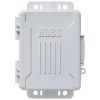HOBO 4-20mA Input Adapter
Features
- Plug-in modular connector for easy interface with HOBO stations
- HOBO RX3000 and U30 stations have room for two adapters
- USB Micro Station and MicroRX Station requires consolidator box and extension cable
- Expedited repair and warranty service
- Lifetime technical support
- More
Overview
The Onsite 12-bit 4-20 mA Input Adapter interfaces with any sensor and provides a 4-20 mA signal to connect to smart sensor-compatible HOBO stations. This adapter features both a non-switched input and a battery-saving switched input that extends the life of external batteries. It also provides a trigger signal for controlling power to attached external sensors while offering digital filtering, which improves measurement accuracy with 32 readings/sample and 60 Hz noise rejection.
Benefits
- 12-bit resolution
- Digital filtering improves measurement accuracy with 32 readings/sample—4-• 20 mA adapter has 60 Hz noise rejection
- Measurement averaging over logging interval further enhances accuracy
- Plug-in modular connector for easy interface with HOBO stations
- Screw terminal for connecting to sensors
- HOBO RX3000 and U30 stations have room for two adapters
- Use with HOBO USB Micro Station and HOBO MicroRX Station requires Smart Sensor Consolidator Box (S-ADAPT-6) and an extension cable
- Represents one data input channel
Measurement range: 4-20 mA (measures down to 0 mA to detect error condition)
Operating temperature range: -40° to 75°C (-40° to 167°F)
Accuracy: ±40 µA ±0.3% of reading (over operating temperature range)
Resolution: ±4.93 µA
Input impedance: 124 ohms (differential input)
Sensor trigger source: Voltage: 2.5 V ±2.4%; maximum current: 1 mA
Warm-up time: 300 ms ±3% (fixed)
Measurement time: 16.6 ms ±3% to filter out 60 Hz noise
Cable length: 14 cm (5.5 inch)
In The News
From Paddles to Phytoplankton: Studying Vermont’s Wildest Lakes
For six months of the year, Rachel Cray, a third-year PhD student at the Vermont Limnology Laboratory at the University of Vermont, lives between a microscope and her laptop, running data. For the other six months, she is hiking and canoeing four of Vermont’s lakes, collecting bi-weekly water samples. Cray studies algal phenology across four lakes in Vermont, US, that have low anthropogenic stress—or in other words, are very remote. Funded by the National Science Foundation Career Award to Dr. Mindy Morales, the lakes Cray researches part of the Vermont Sentinel Lakes Program, which studies 13 lakes in the area and, in turn, feeds into the Regional Monitoring Network, which operates in the Northeast and Midwest US.
Read MoreReimagining Water Filtration: How Monitoring and Science Enhance FloWater Filtration Systems
Over 50% of Americans think their tap water is unsafe , according to the Environmental Working Group (EWG). Other recent surveys have found that number to be as high as 70% of persons surveyed. Whether due to increased public awareness of water quality issues or confusion about how municipal water sources are regulated, there is a clear distrust of tap water in the United States. According to industry expert Rich Razgaitis, CEO and co-founder of the water purification company FloWater, this issue creates a damaging cycle. Razgaitis explained that the health and environmental problems associated with contaminated water aren’t the only issues. As people become increasingly aware that some tap water is unsafe, they resort to bottled water.
Read MoreMonitoring New Hampshire’s Aquatic Ecosystems: Continuous Data Collection in the Lamprey River Watershed
New Hampshire’s aquatic ecosystems provide a range of ecosystem services to the state and region. Resources and services like clean water, carbon storage, climate regulation, nutrient regulation, and opportunities for recreation all depend on New Hampshire’s aquatic ecosystems remaining healthy. Jody Potter, an analytical instrumentation scientist at the University of New Hampshire (UNH), is studying these aquatic ecosystems in hopes of developing an improved understanding of ecosystem services and their interactions with climate change, climate variability, and land use changes. [caption id="attachment_39799" align="alignnone" width="940"] Aquatic sensors in the Merrimack River in Bedford, NH, with I-293 in the background.
Read More
















